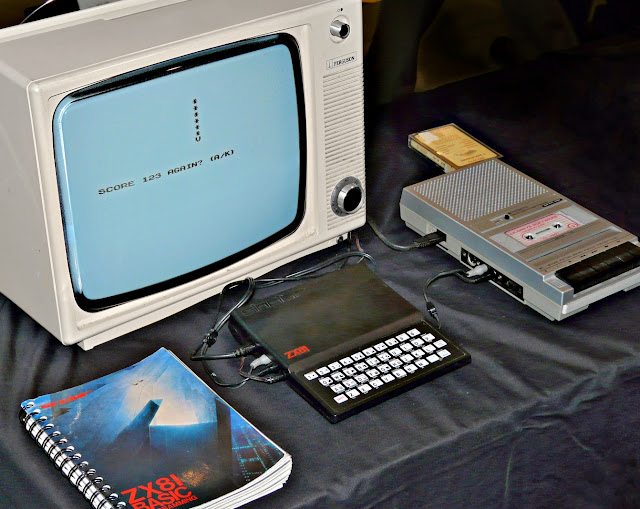Launched March 1981
By early 1981 the microcomputer revolution was well underway, with plenty of options available for people wanting to dip their toe into this new high-tech world. The problem with most of these options was that they were expensive.
In the US, the Commodore VIC-20 was leading the charge on behalf of low-cost computing, but in the UK there had been an even cheaper and more basic computer launched in 1980 in the shape of the Sinclair ZX80 which had been a modest success. But it was Sinclair’s next computer – in the shape of the Sinclair ZX81 – that became the ground-breaking machine that found its way into more than a million homes.
 |
| Sinclair ZX81 |
On paper, the ZX81 was just a minor upgrade to the ZX80. But crucially, Sinclair had redesigned the electronics completely – where the ZX80 had 21 mostly off-the-shelf chips, the ZX81 had just 4. The difference was a custom-built ULA designed and built by computing pioneers Ferranti. This made the whole design simpler, and critically cheaper. A fully-assembled version cost just under £70, compared to £100 for the ZX80. If you were a real cheapskate you could buy a kit for just £49.95 and assemble it yourself.
The ZX81 was a simple but clever system. Smaller than a sheet of paper, the ZX81 boasted a reasonably powerful Z80 CPU clocked at 3.25MHz but only had a tiny 1Kb of RAM as standard. A truly terrible membrane keyboard also came with all the ZX81 BASIC functions pre-printed onto the keys, making it easier to learn how to program the thing. All you needed was a domestic TV and a cassette player so you could save and load programs, and you’d be away. In a strictly limited sense.
Text was a 32 column by 24 line affair, or a limited 64 x 48 pixel graphics display. There was no colour or sound, and anything displayed on the screen ate into the tiny amount of RAM. Also, the limited hardware meant that the ZX81 had to use a fair chunk of processor cycles to update the image which slowed it down.. you could speed things up by using FAST mode which prioritised speed over the display, which would white out when the computer was thinking.
On the back of the ZX81 was a simple edge connector, which most owners used to attach a notoriously wobbly 16Kb RAM pack, but Sinclair also sold a tiny printer that output onto silver paper. But the edge connector could be used for more, and a small cottage industry sprang up making everything from replacement keyboards, sound generators and even disk interfaces. A wide range of decent quality software appeared on tape, and a number of magazines produced printed BASIC programs that the user could laboriously key in and debug.
It was a good-looking system, designed by Rick Dickinson who had a long association with Sinclair. The comprehensive manual also featured gorgeous cover art by sci-fi artist John Harris. The fabulous design didn’t always make up for variable build quality, but certainly the unboxing experience was something a bit special.
 |
| Typical ZX81 configuration with cassette recorder, monochrome TV and manual |
Despite its flaws, the ZX81 was a hugely popular system – especially in the UK. However, an attempt to break through into the US market in partnership with Timex (who assembled the ZX81) met with limited success. A number of other clones – some licenced, some illegal – followed in worldwide markets. Enthusiasts continue to develop hardware and software for the ZX81 even today.
The profits from the ZX81 were substantial, putting Sinclair in an excellent position to develop their next machine, the ZX Spectrum. More importantly, the ZX81 introduced millions of people to computers and programming and helped to make those fields popular in the markets the ZX81 succeeded. Today the ZX81 is quite collectable with a thriving trade in software and add-ons, prices for ones in excellent condition can exceed £100 but there are bargains if you hunt around.
Image credits:
Science Museum Group - CC BY 4.0
Mike Cattell via Wikimedia Commons - CC BY 2.0

No comments:
Post a Comment